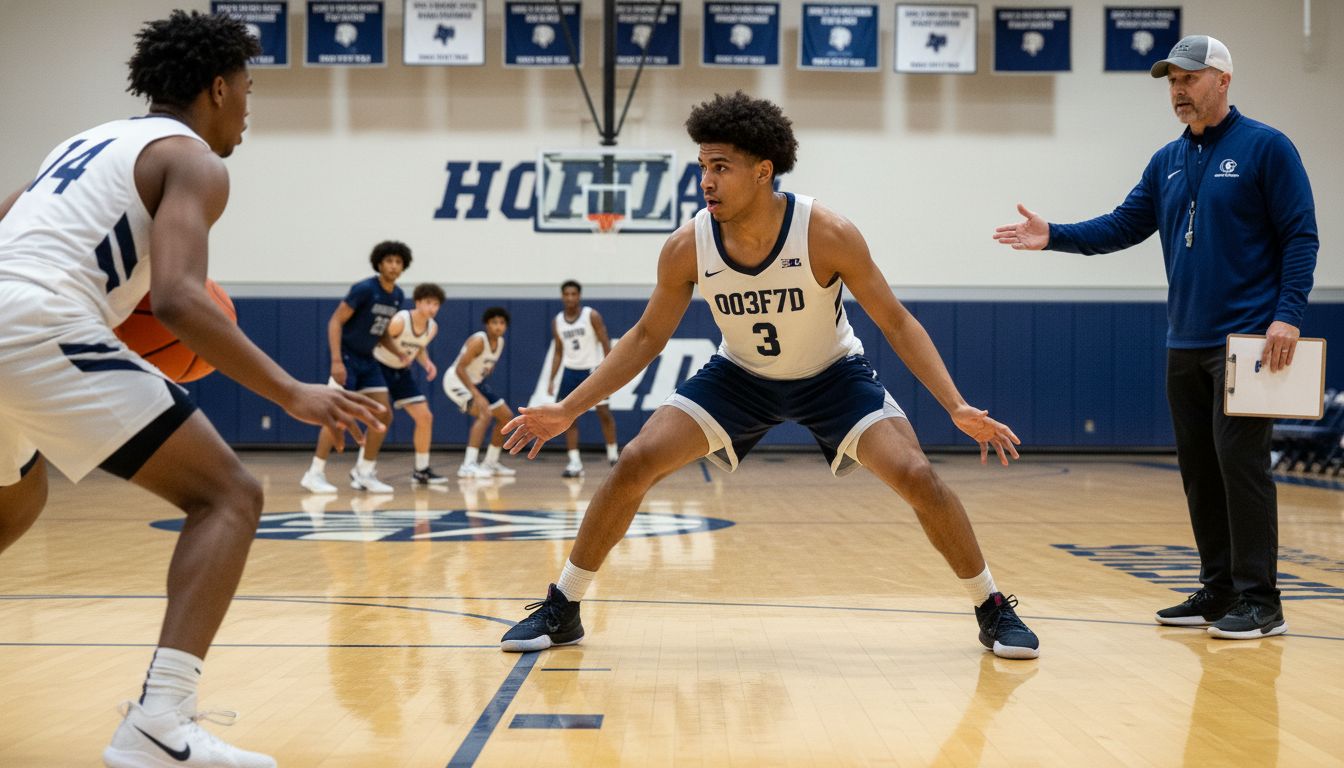Most basketball coaches agree that defense often determines the outcome of close games. Yet, building a tough defensive team takes more than athleticism or hustle. Mastering concepts like stance, communication, and court awareness turns individual players into a united defensive force. With the right understanding of defensive principles, your team can cut opponents’ scoring by as much as 30 percent. Discover the key strategies and systems that power the most effective basketball defenses.
Table of Contents
- Defining Basketball Defensive Concepts And Principles
- Types Of Defensive Systems And Strategies
- Essential Individual And Team Defense Techniques
- Implementing Defensive Concepts In Practice Plans
- Common Defensive Mistakes And How To Prevent Them
Key Takeaways
| Point | Details |
|---|---|
| Defensive Principles | Effective basketball defense hinges on player coordination, communication, and tactical understanding, transforming individual skills into a cohesive team strategy. |
| Defensive Strategies | Man-to-man and zone defenses are fundamental systems; each has unique techniques and advantages that require players to adapt to specific roles. |
| Essential Techniques | Mastery of fundamental defensive skills, including stance and anticipation, is crucial for disrupting offensive plays and enhancing team performance. |
| Practice Structure | Deliberate practice plans that progressively advance from basic techniques to complex tactics are essential for developing intuitive defensive responses in players. |
Defining Basketball Defensive Concepts and Principles
Basketball defense represents a strategic system of protecting your team’s basket while disrupting the opponent’s scoring opportunities. At its core, defensive principles involve coordinated player movements, positioning, communication, and tactical understanding that transform individual skills into a cohesive team strategy.
Successful defensive concepts require players to master fundamental techniques like stance, positioning, and court awareness. These skills enable defenders to anticipate offensive movements, contest shots, and create strategic pressure points. In our essential basketball defense tips, we explore how precise footwork and body positioning can dramatically improve a team’s defensive effectiveness.
Defensive strategies generally fall into two primary categories: man-to-man defense and zone defense. Man-to-man defense assigns each defender a specific offensive player to guard, emphasizing individual matchups and preventing direct scoring lanes. Zone defense, conversely, divides the court into defensive areas where players protect specific zones rather than individual opponents. Each approach offers unique advantages and requires different skill sets from players.
Coaches must understand that effective defense transcends physical skills. It demands mental discipline, constant communication, and a collective commitment to team objectives. Players must learn to read offensive formations, communicate defensive switches, and maintain high-energy defensive postures that disrupt opponent strategies. The most successful defensive teams transform individual defensive talents into a synchronized, anticipatory system that consistently challenges scoring opportunities.
Types of Defensive Systems and Strategies
Basketball defensive strategies can be broadly categorized into two fundamental systems: man-to-man defense and zone defense. According to University of Georgia Open Online Resources, these defensive approaches represent distinct methodologies for protecting the team’s basket and disrupting opponent scoring opportunities.
Man-to-Man Defense is a strategy where each defender is assigned a specific offensive player to guard throughout the possession. This approach demands individual defensive skills, requiring players to track their assigned opponent, contest shots, and prevent scoring lanes. Key characteristics include:
- Direct player-to-player accountability
- Emphasizes individual defensive techniques
- Allows for more aggressive, pressure-based defensive tactics
Zone Defense, conversely, allocates defenders to specific court areas rather than individual players. University of Georgia Open Online Resources highlights that this strategy involves defenders protecting designated zones, which can create unique challenges for offensive teams. Common zone formations include:
- 2-3 Zone: Two players at the top, three along the baseline
- 3-2 Zone: Three players at the top, two near the baseline
- 1-3-1 Zone: One player at the top, three across the middle, one near the baseline
Successful implementation of either defensive system requires comprehensive understanding of player strengths, opponent tendencies, and strategic adaptability.
![]() How to Teach Your Players to Play Good Defense in Basketball emphasizes that coaches must not only choose the right system but also train players to execute its principles with precision, communication, and collective defensive awareness.
How to Teach Your Players to Play Good Defense in Basketball emphasizes that coaches must not only choose the right system but also train players to execute its principles with precision, communication, and collective defensive awareness.
Essential Individual and Team Defense Techniques
Individual defensive techniques form the foundation of successful basketball defense, with fundamental skills that transform players from mere participants into strategic defensive assets. Proper defensive stance, footwork, and anticipation create the critical building blocks for disrupting offensive plays and protecting the team’s basket.
Defensive Stance Fundamentals include:
- Balanced body positioning
- Low center of gravity
- Active hands
- Feet shoulder-width apart
- Weight on the balls of the feet
- Ability to move laterally quickly
Defensive Communication represents another crucial team technique that elevates individual skills into a synchronized defensive system. Players must continuously verbalize opponent movements, screen locations, and potential scoring threats. Essential Defensive Bundle for Coaches highlights the importance of developing a consistent defensive language that allows teammates to anticipate and react collectively.
Advanced defensive techniques involve mastering individual defensive skills like:

- Proper closeout techniques
- Contesting shots without fouling
- Reading offensive player body language
- Understanding defensive help positioning
- Creating defensive pressure without compromising team structure
Successful defensive execution requires seamless integration of individual skills with team strategies, transforming potential vulnerabilities into collective defensive strengths. Coaches must consistently drill these techniques, helping players develop muscle memory and intuitive defensive responses that can adapt to dynamic game situations.
Implementing Defensive Concepts in Practice Plans
Effective defensive skill development requires deliberate, structured practice plans that progressively build individual and team defensive capabilities. Basketball Practice Structure: Complete Coaching Guide emphasizes the importance of creating systematic approaches that transform theoretical defensive concepts into muscle memory and instinctive team responses.
Practice Plan Components for Defensive Training should include:
- Individual defensive skill drills
- Team defensive positioning exercises
- Communication and anticipation scenarios
- Live game-simulation defensive challenges
- Video analysis and tactical breakdown sessions
Coaches must design practice segments that incrementally increase defensive complexity. Begin with fundamental stance and movement drills, then progressively integrate more advanced techniques like help defense, defensive rotations, and situational defensive strategies. Progression is key - players must master basic techniques before attempting complex defensive schemes.
A typical defensive practice segment might follow this structured approach:
- Warm-up and individual defensive stance work (15 minutes)
- One-on-one and two-on-two defensive positioning drills (20 minutes)
- Full-court defensive communication and pressure exercises (15 minutes)
- Scrimmage with specific defensive objectives (20 minutes)
- Video review and tactical discussion (10 minutes)
Successful implementation requires coaches to be both technical instructors and strategic motivators. The goal is not just teaching defensive techniques, but cultivating a defensive mindset that transforms individual players into a cohesive, anticipatory defensive unit.
Common Defensive Mistakes and How to Prevent Them
Defensive effectiveness is often undermined by predictable and repetitive mistakes that can compromise team strategy and individual player performance. Understanding and addressing these common errors is crucial for developing a robust defensive system that can adapt to various offensive challenges.
Most Frequent Defensive Mistakes:
- Losing sight of the ball while guarding an opponent
- Failing to communicate defensive switches
- Improper defensive stance and body positioning
- Overcommitting on defensive plays
- Poor anticipation of offensive movements
- Unnecessary gambling for steals
Players often struggle with positional awareness, which leads to critical defensive breakdowns. 7 Key Steps for a Winning Practice Planning Checklist suggests incorporating specific drills that train players to maintain simultaneous awareness of both their assigned player and the ball’s location. This dual-focus approach helps prevent common positioning errors that create scoring opportunities for opponents.
Preventing defensive mistakes requires a multifaceted approach that combines:
- Consistent technique reinforcement
- Video analysis of defensive breakdowns
- Repetitive situational defensive scenarios
- Mental conditioning to improve court awareness
- Teaching players to understand defensive principles, not just memorize positions
Successful coaches recognize that defensive mistakes are learning opportunities. By systematically breaking down each error, providing constructive feedback, and creating a culture of continuous improvement, teams can transform potential weaknesses into defensive strengths. The key is patience, precise instruction, and helping players develop an intuitive understanding of defensive positioning and team coordination.
Take Your Basketball Defense to the Next Level Today
If mastering basketball defensive concepts and principles feels overwhelming, you are not alone. Coaches often struggle with teaching precise positioning, effective communication, and the right blend of man-to-man and zone strategies. This guide highlights the critical need for drills and practice plans that build both individual skills and team cohesion. When defensive mistakes threaten to unravel your team’s performance, having structured resources becomes essential.

Unlock a winning defensive mindset by exploring our Basketball Drills specifically designed to sharpen stance, footwork, and closeout techniques. Dive deeper with our comprehensive Basketball Guides to help you implement strategic defensive systems confidently. Coach smarter and save valuable time at Hoop Mentality, where our professional resources empower you to build a disciplined, communicative defense that wins games. Start transforming your team’s defense now by visiting us and accessing tools that bring your coaching vision to life.
Frequently Asked Questions
What are the key principles of basketball defense?
Successful basketball defense is built on coordinated player movements, positioning, communication, and tactical understanding, which allows individual skills to function as a cohesive team strategy.
What is the difference between man-to-man defense and zone defense?
Man-to-man defense assigns each player to guard a specific opponent, focusing on individual matchups, while zone defense divides the court into areas where players protect designated zones rather than individual players.
What essential techniques should players master for effective defense?
Players should focus on defensive stance fundamentals, footwork, anticipation, communication, and advanced individual skills like proper closeout techniques and shot contesting without fouling.
How can coaches prevent common defensive mistakes?
Coaches can prevent defensive mistakes by reinforcing consistent techniques, using video analysis to identify breakdowns, and implementing repetitive situational drills to enhance players’ awareness and understanding of defensive principles.

